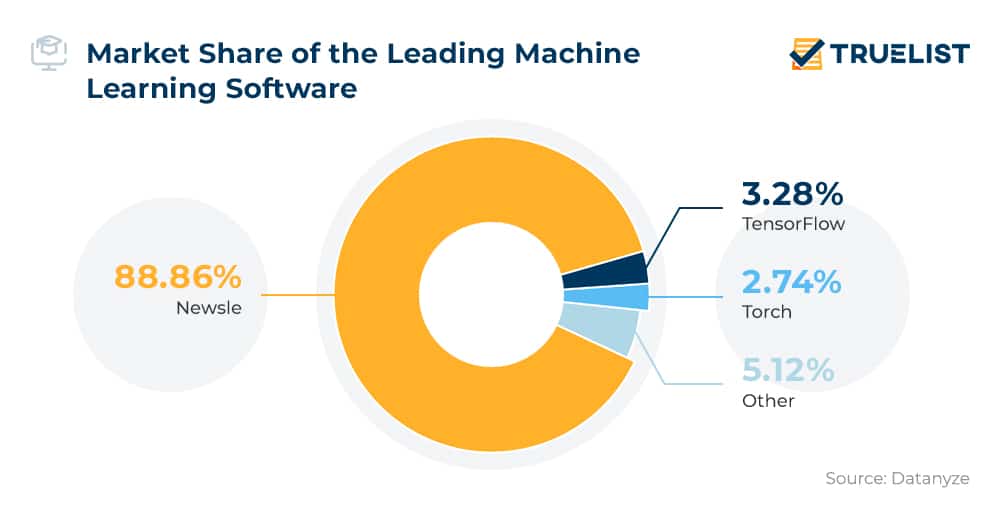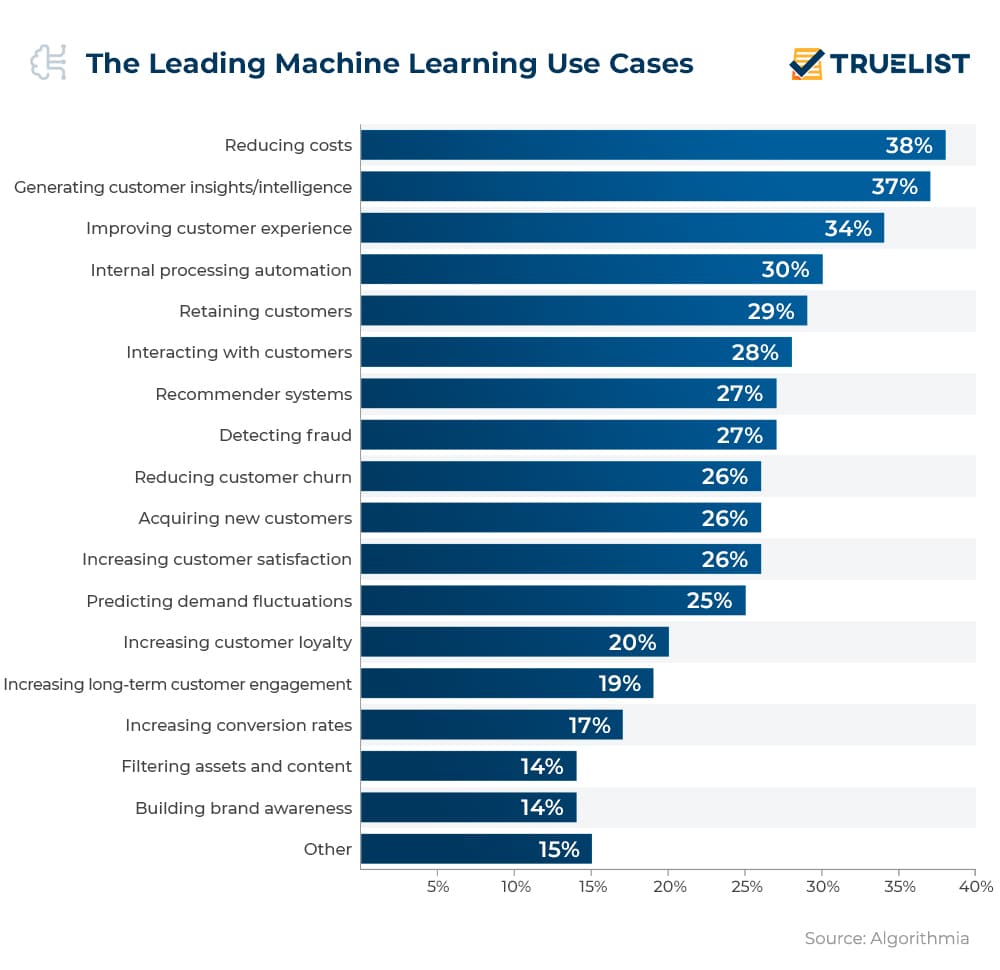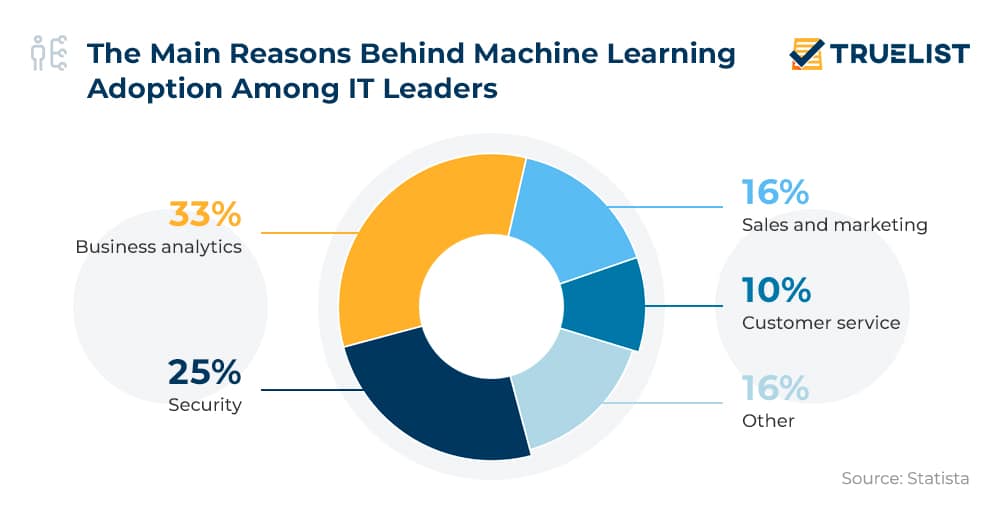Machine learning-based AI-powered applications are all around us, on our GPS, streaming platforms, virtual assistants, even identifying spam emails for us. But they can do a lot more — machine learning statistics show outstanding success in the technology’s commercial use, including enhanced customer satisfaction or higher conversion rates. Read on to discover key takeaways from industry reports, milestones, and fun facts.
Machine Learning Statistics (Editor’s Choice)
- 38% of US jobs can be automated by the early 2030s. (PwC)
- Sales and marketing is the most profitable area for machine learning. (McKinsey)
- 80% of machine learning companies target ecommerce and retail businesses. (Emerj)
- Tensorflow is the number one machine learning platform for 59% of professionals. (Statista)
- Machine learning can enhance customer satisfaction by over 10%. (Forbes)
- Nissan has increased its conversion rate by 67% with a machine learning model. (Think with Google)
- Facebook’s AI-powered face recognition model has 97.35% accuracy. (Facebook Research)
Machine Learning Statistics Rundown
1. The global machine learning market should expand at a 38.76% growth rate between 2020 and 2030.
With tech giants like Amazon or Netflix standardizing the commercial use of machine learning, the market penetration of the AI subset has been outstanding. Today, companies using machine learning implement it in various areas, including image classification, speech recognition, genetics, and weather forecast. What curbs the machine learning market growth is the lack of technological expertise. Machine learning statistics show that businesses that implement the technology struggle with development, resulting in long maturity periods.
(Market Research Future)
2. 59% of professionals see TensorFlow as an important machine learning platform.
Google Brain developed TensorFlow, an open-source machine and deep learning framework, and released it for commercial use in 2015. The platform has since enjoyed vast popularity, and its market share has grown tremendously. Users attribute its success to its flexible architecture and adaptability. TensorFlow’s market share is at 3.28%, right behind LinkedIn’s Newsle, which holds the largest share of the ML software market, i.e., 88.86%.
(Statista, Forbes, Datanyze)

3. Machine learning accounts for the biggest share of AI funding.
Funding for machine learning applications amounted to $28.5 billion, while machine learning platforms received $14.4 billion in 2019. Machine learning statistics show that money gathered for such applications and platforms surpassed the funding of all other artificial intelligence systems combined.
(Statista)
4. 38% of US jobs can be automated by the early 2030s.
As evidenced by artificial intelligence statistics, the US surpasses other key markets, namely the UK (30%), Germany (35%), and Japan (21%). Sectors with the highest risk of automation are transportation and storage at 56%, manufacturing at 46%, and wholesale and retail at 44%. Lower-risk sectors include healthcare and social work at only 17%, according to job-related machine learning facts.
(PwC)
5. The employment of computer and research scientists is expected to grow by 22% from 2020 to 2030.
This rate is much higher than the average for all occupations, which is a mere 4%. With the ever-growing machine learning market size, the relevant occupations are not only secure but also likely to offer excellent job prospects soon.
(BLS)
6. LinkedIn lists 452,732 jobs requiring machine learning skills worldwide.
This stat indicates how prevalent machine learning expertise is becoming in the business world today. The US accounts for over 90,000 of the platform’s machine learning jobs, which isn’t a surprise considering the highest number of LinkedIn users, i.e., 171 million, are from the US.
(LinkedIn)
7. Machine learning statistics rank cost reduction as the number one reason why businesses make use of this technology.
Research indicates that companies with 1,000 employees or more use machine learning for internal applications like reducing spending or automating internal processes. Smaller companies using machine learning, meanwhile, focus primarily on generating customer insights and intelligence and improving customer experience. Overall, the research suggests that as companies grow, they prioritize cost-saving measures and applications, shifting their focus on improving their product lines rather than customer service.
(Algorithmia)

8. The most profitable area to implement machine learning systems is sales and marketing.
Using machine learning for marketing is specifically useful when creating a personalization strategy, with Netflix and Amazon being perfect examples of such practice. Allowing for hyper-personalization algorithms can generate tailored product recommendations based on vast sets of data on consumer behavior, resulting in a substantial increase in sales conversion and customer retention rates.
(McKinsey)
9. 33% of IT leaders said they use machine learning for business analytics.
Machine learning statistics show that a third of IT decision-makers are interested in rolling out machine learning for business analytics. While a quarter of them look to enhance their security processes, 16% of IT directors use machine learning for marketing. Only 10% of leaders looking to adopt ML do so for customer service purposes.
(Statista)

10. 80% of machine learning companies target ecommerce and retail industries.
Machine learning companies favor ecommerce and retail industries the most, followed by online and social media. The commercial use of machine learning is booming in these industries due to the constant creation of quantifiable data and its relatively easy streaming and storage.
(Emerj)
11. 40% of newly filed patent applications in the healthcare sector have an AI or machine learning aspect.
Machine and deep learning statistics show that the European Patent Office (EPO) is increasingly receiving patent applications that include AI and machine learning applications. As a response, they have updated their guidelines to accommodate the rising usage of such programs among applicants. EPO treats AI and machine learning as a form of mathematical method, which is essentially unpatentable as it is considered a non-invention. Yet, if a mathematical method controls a technical system or process, it gains a technical character and becomes patentable.
(Kluwer Patent Blog)
Use-Related Machine Learning Facts
12. Recommendations account for 80% of the movies watched on Netflix.
This year, Netflix is forecast to put aside an astonishing $19 billion for programming, and, so far, the platform’s programming investments have paid off. Using deep learning systems to further enhance its recommendations, the streaming giant gets to know its users on a very personal level and constantly updates itself. Experts think Netflix’s heightened concern over its infrastructure stems from the rise of its competitors, HBO Max, Peacock, Hulu, and Disney+ alongside the classic Amazon Prime.
(Cult of Mac, ResearchGate)
13. Nissan increased its conversion rate by 67% using Google’s automated bidding products.
More and more companies are turning to machine learning marketing solutions to optimize their campaigns, improve their profits, and reach higher productivity levels. Machine learning facts show that Nissan optimized ads in real-time, which gave the company control over where the ads were displayed, and further calibrated customer targeting. Alongside improved conversion rates, the cost per qualified visit was down by 33%.
(Think with Google)
14. 75% of companies using machine learning and AI-enhanced customer satisfaction by over 10%.
According to the latest data, 32% of businesses are investing in customer service to improve customer satisfaction. Marketers that use machine learning to identify, understand, and solve customers’ problems enjoy improved clarity and accuracy. Automation allows them to quickly identify the most effective ways to retain customers and combine selected techniques with personalized interactions.
(Forbes)
15. Facebook’s AI-powered face recognition model has 97% accuracy.
A research group in Facebook’s engineering team developed the neural network system as a graduate project, called DeepFace, in 2015. Deep learning statistics recorded a near-perfect accuracy in identifying faces, but this has resulted in mixed responses. While industry experts consider the system the state-of-the-art brilliance, many took action as it didn’t sit well with rising privacy concerns among internet users. The owner of the largest social media website that currently ranks as the third most popular website worldwide faced a class-action lawsuit after launching its new system.
(Facebook Research, BBC)
16. A machine learning algorithm can detect epilepsy in children with 73% accuracy.
This rate is comparable to similar tests human doctors perform on adults. Yet, it is more impressive as children’s brains are rapidly developing while adult brains are relatively stable. Doctors consider this a breakthrough and are hoping for its quick incorporation into clinical use.
(ScienceDirect)
17. Deep learning statistics show 94.4% accuracy in detecting lung cancer.
Lung cancer has been named the most common cause of cancer death in the US. While early screening reduces mortality up to 45%, the high costs, lengthy procedures, and equipment-related challenges can impede an early diagnosis. Scientists turned to deep learning systems for a viable solution. The algorithm performed either on par or better than human radiologists, demonstrating near-perfect results. The model also reduced false positives by 11% and false negatives by 5%.
(Health IT Analytics)
18. A machine learning model can predict under-performing companies with 62% accuracy.
Microsoft engineers teamed up with a financial partner to automate the preliminary review process of relevant documents for investment decisions. They developed a deep learning model using a one-dimensional neural network based on text extracted from public financial statements of the companies in question.
(Microsoft)
19. Machine learning statistics show 95% accuracy in reading lips.
This is a glorious triumph of robots over humans: the algorithm outperformed experienced human lip readers, tested at 52% accuracy. Called recurrent neural networks (RNN), this type of network has connections between neurons that include loops, being well-suited for processing sequences of inputs. This makes them highly effective in a wide range of applications, from handwriting and texts to speech recognition.
(McKinsey)
20. Human evaluators can only tell AI authors apart half the time, machine learning facts show.
That means we are likely to realize that human writers did not write a given text only 50% of the time. The most recently developed text modeling system, GPT-3, which has 175 billion parameters, is the most comprehensive model ever generated. It has recently published an opinion piece in the Guardian trying to convince humans it is not after world domination. Do you buy it?
(The Conversation)
Machine Learning FAQ
Are machine learning and AI the same?
Although they are used interchangeably, machine learning is a branch of artificial intelligence (AI). AI is the broader concept of machines programmed to mimic humans, carrying out tasks in a way that is ‘intelligent,’ according to AI and machine learning facts. Machine learning is a current application of AI, where computer algorithms build a model based on small to large datasets to make informed predictions or decisions autonomously. The model is generated by examining and comparing the data to find common patterns and investigating nuances. Machine learning is a means of achieving AI.
(Forbes)
Will machine learning replace jobs?
Yes and no. Yes, because the use of machine learning, and other subsets of AI, render certain repetitive jobs obsolete, such as bookkeeping, toll collecting, or proofreading, as evidenced by machine and deep learning statistics. No, because the growing machine learning market size opens up numerous job opportunities within the field of computer science and data engineering. We are still miles away from a full-blown AI revolution where machines can take over everything humans do, but we are slowly adapting to a life of coexistence.
(Built In)
Where is machine learning used?
Machine learning is used in a variety of industries addressing a range of challenges. Most notably, it is used for fraud and risk management, sales and marketing campaign management, disease identification and diagnosis, stock market trading, speech recognition, consumer analytics, and email spam filtering, machine and deep learning statistics show.
(Javatpoint)
When does machine learning fail?
Machine learning fails when the data is of poor quality. Machine learning occurs as a result of analyzing small or large sets of data. It deducts patterns and nuances from the data input, and the insight it gains enhances its performance. When the data is inadequate, algorithms fail to produce meaningful predictions.
(HBR)
Final Thoughts
Machine learning and deep learning-based applications will define the future, everyone agrees. Despite the possibilities it brings, very few enjoy its benefits. The machine learning statistics above show that its use in the business world is still being tested, and professionals need a growing expert workforce for its sustainable development.
Sources: Market Research Future, Statista, Forbes, Datanyze, Statista, PwC, BLS, LinkedIn, Algorithmia, McKinsey, Statista, Emerj, Kluwer Patent Blog, Cult of Mac, ResearchGate, Think with Google, Forbes, Facebook Research, BBC, ScienceDirect, Health IT Analytics, Microsoft, The Conversation, Forbes, Built In, Javatpoint, HBR

